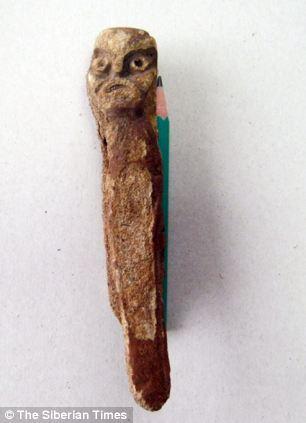Rachel Reilly
Source - http://www.dailymail.co.uk/sciencetech/article-2639643/The-4-000-year-old-whopper-Fisherman-accidentally-catches-rare-Bronze-Age-figurine-pagan-god.html
A Russian fisherman who expected nothing more than a haul of tench and carp ended up catching a 4,000-year-old pagan god statue from the bottom of a riverbed.
Local archaeologists have hailed Siberian Nikolay Tarasov's finding as 'unique and amazing' as well as 'probably worth its weight in gold'.
Mr Tarasov was fishing on a day off from his driving job in the village of Tisul in southern Russia.

He said: 'I used a net, rather than a line, and was hauling it in when I felt the net go heavy and thought it had snagged on a rock.
'I pulled it in by getting my pal to help and was going to chuck it away. But then I stopped when I saw it was a stone with a face.
'I washed the thing in the river - and realised it was a statuette.'

The pagan god 12in (30cm) long, 2in (5cm) wide and carved from bone
The figurine has almond-shaped eyes, a large mouth with full lips, and a ferocious facial expression.
'I took it to a local museum. I needed to sit down when the experts told me that this object was carved at the very beginning of the Bronze Age.
'On the reverse side on the head the carver etched plaited hair. Below the plait there are lines looking like fish scales. The people I showed it to quite literally jumped for joy.
'I suspected it might be a couple of hundred years old, but had not considered it might by older,' he told The Siberian Times.
The curators of the museum passed on the find to experts in the city of Kemerovo, where they dated it at more than 4,000-years-old, and explained it had been carved in horn which later fossilised. The statuette is 12in (30cm) long and 2in (5cm) wide.
Marina Banschikova, director of Tisul History Museum: 'Quite likely, it shows a pagan god.
'Items from this period are very rare, the only things we have dated approximately to the same age are a stone necklace and two charms in the shapes of a bear and a bird.
'Nikolay has given us this treasure free of charge. He didn’t ask for any kind of compensation - though it is probably worth more than if it was a gold statue.
'Now we have to devote more time studying his find which is both unique and amazing.'
The area around Tisul is known to have been inhabited in ancient times.
Currently the theories are that the statuette belonged to the Okunev or Samus cultures.
Okunev culture was a Bronze Age society dated to the first half of the 2nd millennium BC in Minusinsk Hollow of southern Siberia.
To sell it and make profit however was never on the mind of Mr Tarasov, who said: 'People should see it, and learn the history of their region. It is quite clearly precious for the museums of any country.'
WHAT AND WHEN WAS THE BRONZE AGE?
The Bronze Age was a period characterised by the use of bronze, early forms of writing, and other early developments of urban civilization.
It is the second period of the three-age 'Stone-Bronze-Iron' system for classifying and studying ancient societies.
The Bronze Age was a time of intensive metal use and of developing trade networks and began around 4,000 years ago.
In order to make bronze, tin is mined and smelted separately, then added to molten copper to make a bronze alloy.
The overall period is characterised by the adoption of bronze in many regions, though the place and time of the introduction and development of such technology was not simultaneous.
Worldwide, the Bronze Age generally followed the Neolithic period, but in some parts of the world, the Copper Age is sandwiched between the Neolithic and Bronze Age.
The Altai Mountains, in what is now southern Russia and central Mongolia, have been identified as the point of origin of a cultural moment called the Seima-Turbino Phenomenon.
It's believed that climate change in the region around 2000BC and the following ecological, economic and political changes triggered a rapid and mass migration westward into northeast Europe, eastward into China and southward into Vietnam and Thailand across a frontier of some 4,000 miles.
This migration took place in just five to six generations and led to people from Finland in the west to Thailand in the east employing the same bronze making technology and, in some areas, horse breeding and riding.